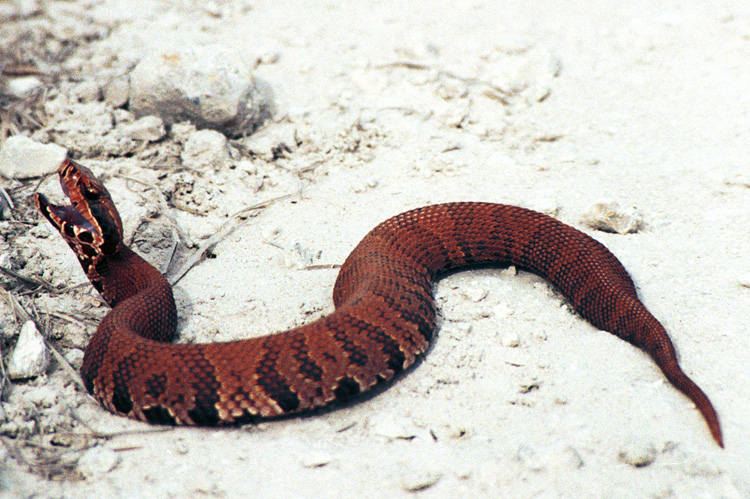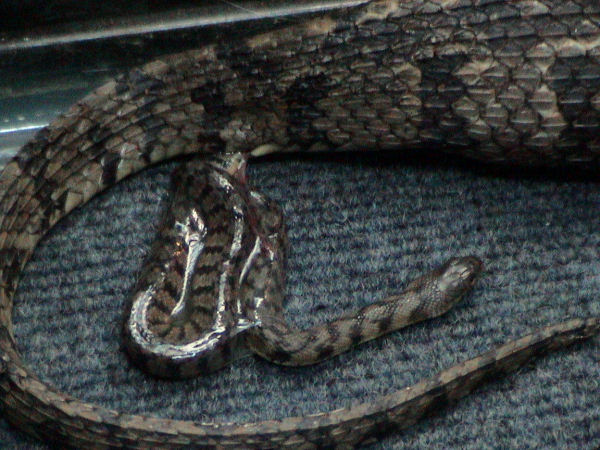|
Roger Conant (herpetologist)
Roger Conant (May 6, 1909 – December 19, 2003) was an American herpetologist, author, educator and conservationist. He was Director Emeritus of the Philadelphia Zoo and adjunct professor at the University of New Mexico. He wrote one of the first comprehensive field guides for North American reptiles in 1958 entitled: ''A Field Guide to Reptiles and Amphibians of Eastern and Central North America'', in the Peterson Field Guide series. Biography Born in Mamaroneck, New York, Conant lost his father when he was young. When he was a teenager he took a job at a local zoo to help his mother make ends meet, which, along with participating in the Boy Scouts of America, began his lifelong passion for reptiles. He was the first Eagle Scout in Monmouth County Council, New Jersey in 1924. He moved to Toledo, Ohio in 1929 and worked as Curator of Reptiles, and later General Curator at the Toledo Zoo from 1929 to 1935. In 1935 he returned to Philadelphia and became the Curator of Reptil ... [...More Info...] [...Related Items...] OR: [Wikipedia] [Google] [Baidu] |
Herpetology
Herpetology (from Greek ἑρπετόν ''herpetón'', meaning " reptile" or "creeping animal") is the branch of zoology concerned with the study of amphibians (including frogs, toads, salamanders, newts, and caecilians (gymnophiona)) and reptiles (including snakes, lizards, amphisbaenids, turtles, terrapins, tortoises, crocodilians, and the tuataras). Birds, which are cladistically included within Reptilia, are traditionally excluded here; the scientific study of birds is the subject of ornithology. Thus, the definition of herpetology can be more precisely stated as the study of ectothermic (cold-blooded) tetrapods. Under this definition "herps" (or sometimes "herptiles" or "herpetofauna") exclude fish, but it is not uncommon for herpetological and ichthyological scientific societies to collaborate. Examples include publishing joint journals and holding conferences in order to foster the exchange of ideas between the fields, as the American Society of Ichthyologists a ... [...More Info...] [...Related Items...] OR: [Wikipedia] [Google] [Baidu] |
Chihuahuan Desert Research Institute
The Chihuahuan Desert Research Institute or CDRI, incorporated in December 1973, is an independent non-profit, scientific and educational organization conducting its operations as a multi-featured Nature Center and Botanical Gardens located on a tract in the foothills of the Davis Mountains. The organization's mission is to promote public awareness, appreciation, and concern for nature generally and the natural diversity of the Chihuahuan Desert region specifically through education, the visitor experience, and through the support of research. Its original principal founders were Science professors at Sul Ross State University, a university that the institute continues to work closely with, as well as a variety of other TEA Region 18 public schools, grades Pre-K through 12, regional colleges and universities, and other non-profit organizations. Since 2018, Lisa Fargason Gordon has served as the Executive Director, working with a small team of employees, along with many members, volu ... [...More Info...] [...Related Items...] OR: [Wikipedia] [Google] [Baidu] |
Agkistrodon Conanti
The Florida cottonmouth (''Agkistrodon conanti'') is a species of venomous snake, a pitviper in the subfamily Crotalinae of the family Viperidae. The species is endemic to the United States, where it occurs in southern Georgia and the Florida peninsula in nearly every type of wetlands in the region, including brackish water and offshore islands. However, it is not entirely dependent on water and is occasionally encountered as far as a mile (1.6 km.) from surface water. ''Agkistrodon conanti'' venom is very hemolytic and known to cause relatively extensive necrosis compared to many snake venoms, and can sometimes be lethal with a 17% mortality rate. Ernst CH, Ernst EM (2011). ''Venomous Reptiles of the United States, Canada, and Northern Mexico, Volume 1: ''Heloderma, Micruroides, Micrurus, Pelamis, Agkistrodon, Sistrurus. Baltimore: The Johns Hopkins University Press. xviii + 352 pp. It is often confused with harmless watersnakes ('' Nerodia'') and other semi-aquatic speci ... [...More Info...] [...Related Items...] OR: [Wikipedia] [Google] [Baidu] |
Neurophyseta Conantia
''Neurophyseta conantia'' is a moth in the family Crambidae. It was described by Eugenie Phillips-Rodriguez and Maria Alma Solis Maria Alma Solis is a entomologist at the Systematic Entomology Laboratory (SEL) of the Agricultural Research Service of the U.S. Department of Agriculture. Early life Maria Alma Solis was born on February 9, 1956, in Corpus Christi, Texas, ... in 1996. It is found in Costa Rica. Etymology The species is named for Roger Conant. References Moths described in 1996 Musotiminae {{Musotiminae-stub ... [...More Info...] [...Related Items...] OR: [Wikipedia] [Google] [Baidu] |
Massachusetts Bay Company
Massachusetts (Massachusett: ''Muhsachuweesut Massachusett_writing_systems.html" ;"title="nowiki/> məhswatʃəwiːsət.html" ;"title="Massachusett writing systems">məhswatʃəwiːsət">Massachusett writing systems">məhswatʃəwiːsət'' English: , ), officially the Commonwealth of Massachusetts, is the most populous state in the New England region of the Northeastern United States. It borders on the Atlantic Ocean and Gulf of Maine to the east, Connecticut and Rhode Island to the south, New Hampshire and Vermont to the north, and New York to the west. The state's capital and most populous city, as well as its cultural and financial center, is Boston. Massachusetts is also home to the urban core of Greater Boston, the largest metropolitan area in New England and a region profoundly influential upon American history, academia, and the research economy. Originally dependent on agriculture, fishing, and trade. Massachusetts was transformed into a manufacturing center during the ... [...More Info...] [...Related Items...] OR: [Wikipedia] [Google] [Baidu] |
Salem, Massachusetts
Salem ( ) is a historic coastal city in Essex County, Massachusetts, located on the North Shore of Greater Boston. Continuous settlement by Europeans began in 1626 with English colonists. Salem would become one of the most significant seaports trading commodities in early American history. It is a suburb of Boston. Today Salem is a residential and tourist area that is home to the House of Seven Gables, Salem State University, Pioneer Village, the Salem Maritime National Historic Site, Salem Willows Park, and the Peabody Essex Museum. It features historic residential neighborhoods in the Federal Street District and the Charter Street Historic District.Peabody Essex announces $650 million campaign WickedLocal.com, November 14, 2011 [...More Info...] [...Related Items...] OR: [Wikipedia] [Google] [Baidu] |
Roger Conant (Salem)
Roger Conant ( – November 19, 1679) was an English colonist and drysalter credited for establishing the communities of Salem, Peabody, Beverly and Danvers, Massachusetts (Peabody, Beverly and Danvers were part of Salem during his lifetime).Bartlett, Sarah S. ''Roger Conant in America: Governor and Citizen,'' An Historical Address Delivered at the Conant Family Reunion, Hotel Vendome, Boston, June 13, 1901, p. 8.Shipton, Clifford K. ''Roger Conant: A Founder of Massachusetts,'' p. 53-4, Harvard University Press, Cambridge, Massachusetts, 1944. Conant arrived at Plymouth Colony from London in 1624, where he became associated with Puritan opposition and subsequently led the settlement to outlying areas, including the site of an ancient Native American village and trading center, which would later become Salem. Conant's leadership provided the stability to survive the first two years in Salem, but John Endecott, one of the new arrivals, replaced him by order of the Ma ... [...More Info...] [...Related Items...] OR: [Wikipedia] [Google] [Baidu] |
Agkistrodon
''Agkistrodon'' is a genus of venomous pit vipers commonly known as American moccasins.Crother, B. I. (ed.). 2017. ''Scientific and Standard English Names of Amphibians and Reptiles of North America North of Mexico, with Comments Regarding Confidence in Our Understanding.'' SSAR Herpetological Circular 43, 1–102 pp. (page 59)Liner, E. A. and G. Casas-Andreu. 2008. ''Standard Spanish, English and scientific names of the amphibians and reptiles of Mexico.'' Society for the Study Amphibians and Reptiles. Herpetological Circular 38: i-iv, 1-162. (pages 95-96) The genus is endemic to North America, ranging from the Southern United States to northern Costa Rica. Eight species are currently recognized,Porras, Louis W., Larry David Wilson, Gordon W. Schuett, and Randall S. Reiserer 2013. ''A taxonomic reevaluation and conservation assessment of the common cantil, Agkistrodon bilineatus (Squamata: Viperidae): a race against time''. Amphibian & Reptile Conservation 7(1): 48–73. all o ... [...More Info...] [...Related Items...] OR: [Wikipedia] [Google] [Baidu] |
Howard K
Howard is an English-language given name originating from Old French Huard (or Houard) from a Germanic source similar to Old High German ''*Hugihard'' "heart-brave", or ''*Hoh-ward'', literally "high defender; chief guardian". It is also probably in some cases a confusion with the Old Norse cognate ''Haward'' (''Hávarðr''), which means "high guard" and as a surname also with the unrelated Hayward. In some rare cases it is from the Old English ''eowu hierde'' "ewe herd". In Anglo-Norman the French digram ''-ou-'' was often rendered as ''-ow-'' such as ''tour'' → ''tower'', ''flour'' (western variant form of ''fleur'') → ''flower'', etc. (with svarabakhti). A diminutive is "Howie" and its shortened form is "Ward" (most common in the 19th century). Between 1900 and 1960, Howard ranked in the U.S. Top 200; between 1960 and 1990, it ranked in the U.S. Top 400; between 1990 and 2004, it ranked in the U.S. Top 600. People with the given name Howard or its variants include: G ... [...More Info...] [...Related Items...] OR: [Wikipedia] [Google] [Baidu] |
Nerodia
''Nerodia'' is a genus of nonvenomous colubrid snakes commonly referred to as water snakes due to their aquatic behavior. The genus includes nine species, all native to North America. Description ''Nerodia'' species In biology, a species is the basic unit of Taxonomy (biology), classification and a taxonomic rank of an organism, as well as a unit of biodiversity. A species is often defined as the largest group of organisms in which any two individuals of ... vary greatly, but all are relatively heavy-bodied snakes, sometimes growing to 1.2 m (4 feet) or longer in total length. They have flattened heads, with small eyes that have round pupils, and keeled dorsal scales. Species like ''Nerodia fasciata, N. fasciata'' display distinct banding, whereas other species, like ''Nerodia erythrogaster, N. erythrogaster'', have blotching, and those like ''Nerodia rhombifer, N. rhombifer'' have diamond-shaped patterning. Most species are brown or olive green, or some combination ther ... [...More Info...] [...Related Items...] OR: [Wikipedia] [Google] [Baidu] |





.jpg)
